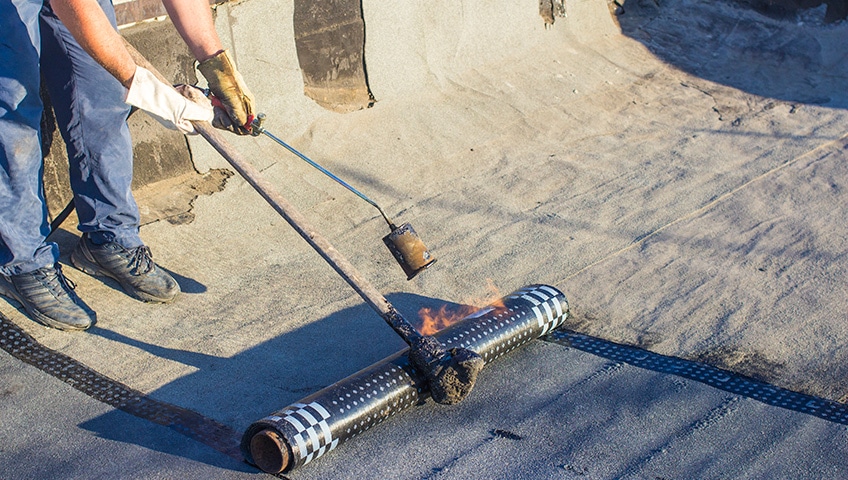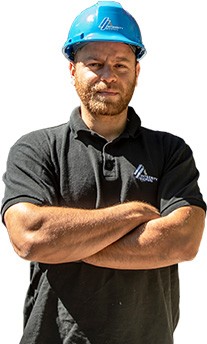
Signs of Commercial Roof Damage
October 27, 2019
Operating a commercial facility is a big responsibility. Maintenance and upkeep will take up a lot of your time. There are signs that tell when your building will need commercial flat roof repair services when you know what to look for. Missing shingles is one of the obvious signs. Water penetrates the area where the shingle was, and then it will breach the leak barrier. Once water makes its way in, it will saturate the area and leak into the roofing system. A flat roof repair in Toronto is the best way to keep the problem in check.
Another visual clue that you have water problems is stains on the walls or ceiling. This problem is called puddle saturation. Toronto roofers with experience in the commercial sector will know what to do to stop the problem. When you see the stains, the water entry point will be somewhere within the puddle area. A Toronto roof repair will correct the problem. Water stains on walls say the wall is infected, and it demands a roof leak repair. When leaks aren’t discovered quickly, they pose a health hazard. Mold and mildew are the hazards here. Your nose will detect the problem. You smell an odour, the catalyst for roof repairs in Toronto. When you find mold, you should be aware that this is the result of a long-term leak. When mold proliferates, the odour tells you that it could be weeks or months in the making. When you enter your building and see water on the floor, it is a problem. Whether on the shop floor or the office, it is a sign that indicates a roofing repair is required.
What are the causes of commercial damage and leaks?
- An inadequate or no drainage system is a big problem for a flat roof. A commercial roof has a slight pitch to help move water to drainpipes and downspouts. If they aren’t installed, water will pond, and puddles develop. Water wasn’t intended to stand on a roof. That is why the drainage system and gutters must be in good working order to move water. If the water doesn’t move, it creates stress your roof wasn’t designed to absorb. Your roofing system will be forced to deal with pressure on the supports caused by the weight of the water. For every square foot of water ponding on your roof, it creates five pounds of extra weight per square inch for your roof to support. A roof, in the best of condition, can’t handle this load for a long time. A saturated, weakened roof will develop soft spots that will be visible upon inspection.
- The flashing on a roof is a weak point that water will exploit. It is one of the most common problems for a flat roof when dealing with leaks. Flashing is a protective cover for areas where the roof meets like junctions. The flashing seal is made of metal or a membrane shell that covers the cracks and seams on a roof. It will wear over time and needs to be inspected regularly. Your roof absorbs heat and cold – expansion and contraction – which will reduce the functionality of the flashing over time. The roof movement – slight as it is – will loosen the flashing and create small openings for water to enter.
- A roof’s membrane is how it channels water to drains and gutters for distribution on the ground. The membrane acts like lamination, creating a waterproof seal between the roof and the outer environment. Time, wear and tear, cause leaks. And a membrane will only last so long. An indication of membrane problems will be seen in the condition of the membrane. Upon inspection, blisters and cracks will tell you that the membrane has been damaged. Saturation points are inevitable at the weak spots of the membrane with leaks to follow.
- Ventilation for a building can be another problem for the commercial building owner. Pipes or openings atop your flat roof were created for fresh air return. In most cases, the openings are secured against water leaks. Over time, water droplets from rainstorms or snowmelt can harm the roof, the start of roof leaks. Without an adequate drainage system, the problem escalates quickly without notice, impacting the roofing insulation.
- Detecting roof cracks or punctures is one of the most important things you can do as a building owner or operator. It is the most direct way for water to enter your building and expand the source of entry. The impact is thousands of dollars in repairs to seal the area of the problem and to remediate all internal damage to the roofing system. Water on the floor in your building will be the moment you know that the crack has reached an advanced state. A call to a roofing contractor is the only solution to the problem.
- For a roofing system that has been in working order for many years, weather and age play a role in its degradation. The four seasons, weather events and the constant pounding of UV rays will wear down any roofing system. In the winter, snow is the biggest enemy a roofing system can have. It is frozen water that you can’t drain from your roof. The added weight of the snow and its ability to saturate a roof is how the damage transpires. During a period of sub-zero temperatures, the damage that snow will do is multiplied. That creates an unsafe situation for the roof supports.
Commercial roof leaks come with considerations that should be examined before you decide on a repair of roof replacement. The age of a roof is one point to mention. Your flat roof is made to last at least 30-years. If the roof is approaching the end of its life cycle, a replacement is the best way to go. Small repairs add up, and fixing a damaged roof is a money pit waiting to happen. A roof with a history of leaks and damage may be a sign that poor materials were used or installed incorrectly. Consequently, any money spent trying to correct the problem is wasted. A new roof is what is in order here. Damage done to the roof by flying debris after a weather event or damage done to the roof from the event will dictate a roof replacement. Some repairs aren’t worth doing when you can extend the life of the building with a new roof. When you review the expenses for your building, rising energy costs will tell you all is not right on the roof. Heat loss is responsible for up to a 20 percent increase in costs. The current state of repair of the building will be another detail to examine when determining your roof’s future. Roof damage impacts building structural support. If the damage has festered, your building will need work also. Installing a new roof without bracing the structural support is inviting a collapse. If your building can’t hold up the roof due to weakness, what is the point of installing a new roof?
Hire a Professional to Detect Damages to Your Commercial Roof
Before you do anything, do your due diligence. Find out what your roofing problems are and what solutions are available. A professional roofing contractor with a background in flat roofing will be able to provide that information. It never hurts to obtain a second or third opinion when seeking roofing advice, but the overriding consideration should be a consultation with a contractor.
You might also want to check our related posts:



















